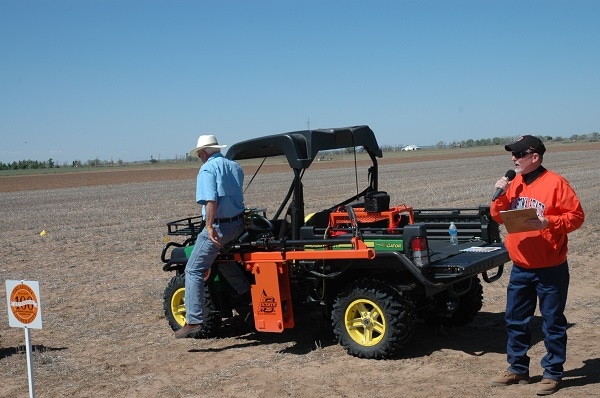
Tipton is a peaceful little farming community in Southwest, Oklahoma, about 40 minutes north of the Texas State line and about 20 miles east of Altus. Grain silos, by far the tallest structures in Tipton proper, silhouetted against a cloudless blue sky and visible for miles across the flat plains, stand as stark and proud reminders that this is farm country.
A person can drive through Tipton in less than three minutes without breaking a speed limit.
One could be tempted to think that nothing of import ever happens in this icon of rural America. One would be wrong.
November 7, 2011, proves the point but may not be the best example. On that afternoon an EF-4 tornado hit southwest of the town and destroyed a structure that had served Tipton, as well as Oklahoma agriculture, since 1938. Beginning as the Southwestern Cotton Substation, the agriculture research facility was the first research station established in Oklahoma dedicated to cotton research.
For more information on SW research and other issues, please check out Southwest Farm Press Daily and receive the latest news right to your inbox.
The tornado may be the most memorable event to affect Tipton in recent years, but for 75 years previously the substation, later renamed the Southwest Agronomy Research Station, had done groundbreaking work to benefit Oklahoma agriculture.
Losing that facility would have been a blow to Oklahoma agriculture research.
Unique history
“There is a lot of unique history with this station,” said Randy Boman, Oklahoma Extension Cotton Program Leader and Director of the Southwest Agriculture Research and Extension Center in Altus, during a recent field day and dedication of a new facility renamed The Tipton Valley Research Center.
“The station has featured a lot of cotton breeding work over the years,” Boman said, “as well as a lot of work on Verticillium wilt, which, unfortunately, is still with us.”
Boman said rebuilding the structure offers a tremendous benefit to OSU research leaders who come from the Stillwater campus to evaluate test plots. The facility, a 50-foot by 100-foot enclosed structure has an additional 25-foot by 50-foot covered shed and includes an integrated office, laboratory and shop space. “It will serve the needs of researchers for many years to come,” Boman said.
The new structure will support what Boman describes as “an important experiment station for Oklahoma State University. This site has some of the best soil in the state,” he said. “It’s also extremely valuable to nutrient research because large areas of the farm have been cropped out, leaving no residual fertilizer. That’s good for nutrient research.”
Current research
Current research includes grain sorghum, cotton, wheat and some Bermudgrass plots. “We will probably have some canola in the fall. Historically, research has included guar, mung beans and alfalfa. This has been a valuable resource for Oklahoma agriculture research.”
For 2013/14 ag research, the site includes 15 different experiments and 1,240 separate plots. Projects include soil fertility; variety trials for wheat, cotton, and grain sorghum; tillage trials; and herbicide and insecticide trials.
Participants in the field day and dedication ceremony, which also included remarks about the 100th anniversary of the Cooperative Extension Service, toured some of the research projects.
Boman said the tornado in 2011 “destroyed all standing structures and more than 110 trees on the farm.” Cleanup required several months of employee time, and more than 60 trailer loads of debris was removed.
Bob Mills Company, Altus, built the new structure. The process of rebuilding took almost two-and-a-half years and was funded by the Oklahoma Agricultural Experiment Station.
Boman said Commissioner Jimmy Smith and Tillman County District 1 employees “provided outstanding support and assistance.”
Dr. Mike Woods, interim Vice President and Dean of the Department of Agricultural Science and Natural Resources, officially opened the building with a ceremonial ribbon cutting.
Dr. James Trapp, Associate Director of the Oklahoma Cooperative Extension Service, referencing Extension’s 100th anniversary, noted the connection modern agriculture has with farm issues of 100 years ago. “After 100 years, Extension is as relevant as ever,” he said. “The farming methods may have changed but problems remain.”
He said when the Extension Service was created, the boll weevil had begun its inexorable march across the Cotton Belt, showing farmers the danger of depending on one crop.
“And now, drought continues as a persistent problem in Western Oklahoma.”
Dr. Jonathan Edelson, Associate Director, Oklahoma Agricultural Experiment Station, put the day in perspective as participants celebrated a new building and continued efforts to solve some of agriculture’s most fundamental production problems.
“Focus and prioritization,” he said. “That’s what we’re doing here.”
About the Author(s)
You May Also Like






